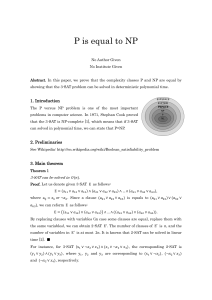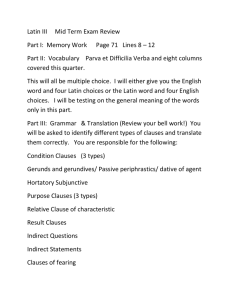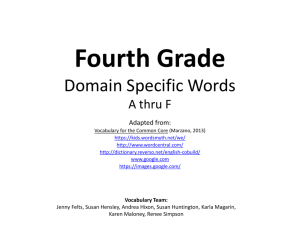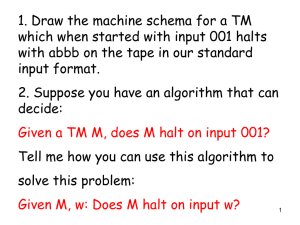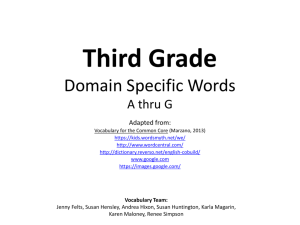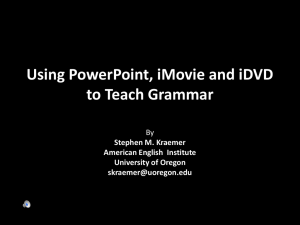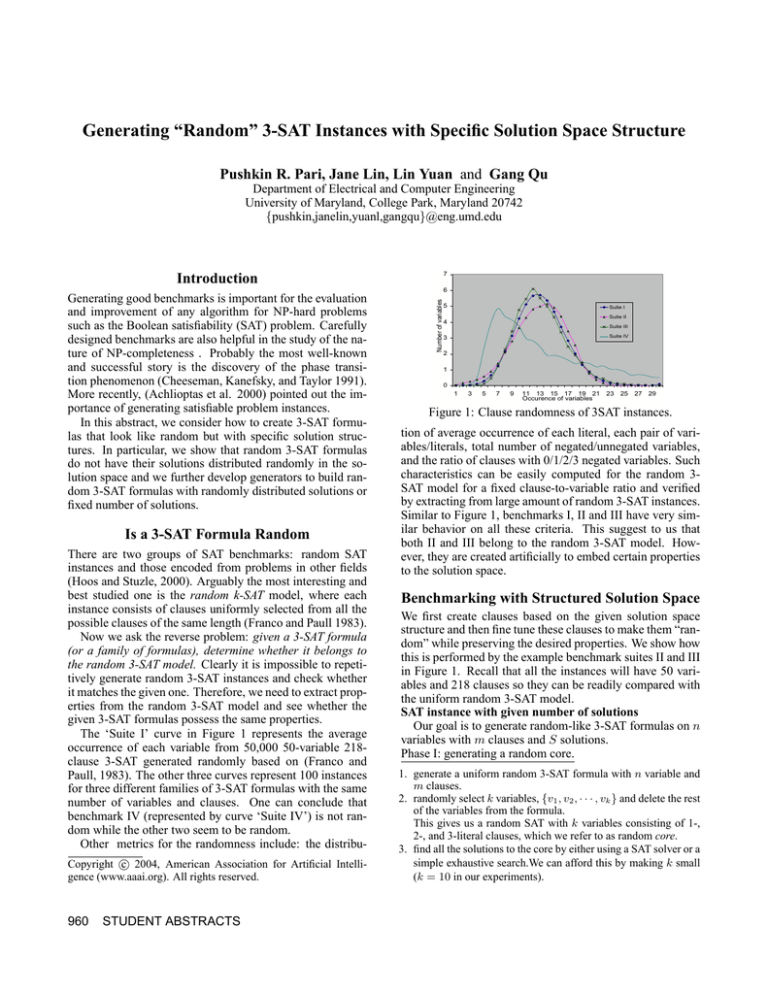
Generating “Random” 3-SAT Instances with Specific Solution Space Structure
Pushkin R. Pari, Jane Lin, Lin Yuan and Gang Qu
Department of Electrical and Computer Engineering
University of Maryland, College Park, Maryland 20742
{pushkin,janelin,yuanl,gangqu}@eng.umd.edu
7
Introduction
Is a 3-SAT Formula Random
There are two groups of SAT benchmarks: random SAT
instances and those encoded from problems in other fields
(Hoos and Stuzle, 2000). Arguably the most interesting and
best studied one is the random k-SAT model, where each
instance consists of clauses uniformly selected from all the
possible clauses of the same length (Franco and Paull 1983).
Now we ask the reverse problem: given a 3-SAT formula
(or a family of formulas), determine whether it belongs to
the random 3-SAT model. Clearly it is impossible to repetitively generate random 3-SAT instances and check whether
it matches the given one. Therefore, we need to extract properties from the random 3-SAT model and see whether the
given 3-SAT formulas possess the same properties.
The ‘Suite I’ curve in Figure 1 represents the average
occurrence of each variable from 50,000 50-variable 218clause 3-SAT generated randomly based on (Franco and
Paull, 1983). The other three curves represent 100 instances
for three different families of 3-SAT formulas with the same
number of variables and clauses. One can conclude that
benchmark IV (represented by curve ‘Suite IV’) is not random while the other two seem to be random.
Other metrics for the randomness include: the distribuc 2004, American Association for Artificial IntelliCopyright gence (www.aaai.org). All rights reserved.
960
STUDENT ABSTRACTS
Number of variables
6
Generating good benchmarks is important for the evaluation
and improvement of any algorithm for NP-hard problems
such as the Boolean satisfiability (SAT) problem. Carefully
designed benchmarks are also helpful in the study of the nature of NP-completeness . Probably the most well-known
and successful story is the discovery of the phase transition phenomenon (Cheeseman, Kanefsky, and Taylor 1991).
More recently, (Achlioptas et al. 2000) pointed out the importance of generating satisfiable problem instances.
In this abstract, we consider how to create 3-SAT formulas that look like random but with specific solution structures. In particular, we show that random 3-SAT formulas
do not have their solutions distributed randomly in the solution space and we further develop generators to build random 3-SAT formulas with randomly distributed solutions or
fixed number of solutions.
5
Suite I
Suite II
4
Suite III
Suite IV
3
2
1
0
1
3
5
7
9
11 13 15 17 19 21
Occurence of variables
23
25
27
29
Figure 1: Clause randomness of 3SAT instances.
tion of average occurrence of each literal, each pair of variables/literals, total number of negated/unnegated variables,
and the ratio of clauses with 0/1/2/3 negated variables. Such
characteristics can be easily computed for the random 3SAT model for a fixed clause-to-variable ratio and verified
by extracting from large amount of random 3-SAT instances.
Similar to Figure 1, benchmarks I, II and III have very similar behavior on all these criteria. This suggest to us that
both II and III belong to the random 3-SAT model. However, they are created artificially to embed certain properties
to the solution space.
Benchmarking with Structured Solution Space
We first create clauses based on the given solution space
structure and then fine tune these clauses to make them “random” while preserving the desired properties. We show how
this is performed by the example benchmark suites II and III
in Figure 1. Recall that all the instances will have 50 variables and 218 clauses so they can be readily compared with
the uniform random 3-SAT model.
SAT instance with given number of solutions
Our goal is to generate random-like 3-SAT formulas on n
variables with m clauses and S solutions.
Phase I: generating a random core.
1. generate a uniform random 3-SAT formula with n variable and
m clauses.
2. randomly select k variables, {v1 , v2 , · · · , vk } and delete the rest
of the variables from the formula.
This gives us a random SAT with k variables consisting of 1-,
2-, and 3-literal clauses, which we refer to as random core.
3. find all the solutions to the core by either using a SAT solver or a
simple exhaustive search.We can afford this by making k small
(k = 10 in our experiments).
16
14
6
12
5
10
4
3
2
1
0
-1
8
Average No. of pairs of solutions
18
7
Average No. of pairs of solutions
Average No. of paris of solutions
8
0
10
20
30
40
50
Hamming distance
Figure 2: Solution randomness of randomly selected solutions.
8
6
4
2
0
-2
0
10
20
30
Hamming distance
40
50
Figure 3: Solution randomness of uniform random 3-SAT instances.
7
6
5
4
3
2
1
0
-1
0
10
20
30
40
50
Hamming distance
Figure 4: Solution randomness of
benchmark suite III.
We have successfully generated 100 formulas using this
approach with the total number of solutions varying from
1 to 5,000, the same range as we have observed from the
50,000 uniform random 3-SAT instances. These instances
pass all the randomness test we listed in the previous section.
than Figure 3, which implies that the formulas we generate
have random solutions in terms of the pairwise Hamming
distance. Furthermore, the formula’s randomness has also
been tested as shown in Figure 1. Due to space limitation,
we briefly mention the procedure of how to build the benchmarks in Figure 4 without elaborating the details.
We start with k randomly selected solutions and then find
local clauses that all the k solutions satisfy. By the term local clauses, we mean clauses consists of literals only from
10 pre-selected random variables. These clause will eliminate part of the non-solutions. We repeat this for about
100 times to ensure the randomness of clauses and the elimination of all non-solutions. Next, we remove the redundancy from clauses. A clause C in formula F is redundant
if F = F\C, the formula obtained by removing C from F.
Whether C is redundant can be determined by checking the
˙
satisfiability of formula C ′ (F\C).
After removing all the redundancy, we observe that there are around 180 clauses left.
We then gather the statistical information about this formula
and add extra clauses to make the total number of clauses
218 and make the formula look as “random” as possible.
The existence of solutions with extremely small Hamming distance (around 2-4) in Figure 4 is due to the fact
that it becomes almost impossible to eliminate all the nonsolutions when large number of solutions are selected randomly. We compensate this by selecting 10-20 random solution and including their neighbors as solutions if the desired
number of solutions is large.
SAT instance with randomly distributed solutions
The uniform random 3-SAT model does not guarantee
that the solutions are randomly distributed. One evidence
is the so-called backbone, variables that remain constant in
all the solutions (Singer, Gent, and Smaill 2000).
To get a quantitative measurement of the solution randomness, we solve the SAT formula for all the solutions and then
compute the Hamming distance between each pair of solutions. Figures 2-4 plot the average number of pairs with the
same Hamming distance for 100 sets of solutions, with each
set contains 10-64 solutions, over three different families. In
Figure 2, the solutions are selected randomly and we see the
perfect bell shape of the normal Gaussian distribution. Figure 3 is based on uniform random 3-SAT formulas, where
we need about 1,000 instances to find 100 instances with solutions in the range of 10-64. Figure 4 is drawn based on instances we generate to have the 10-64 solutions “randomly”
distributed. Figure 4 looks much more similar to Figure 2
Achlioptas, D., Gomes, C. Kautz, H., and Selman, B. 2000. Generating satisfiable problem instances. In Proceedings of the Tenth
National Conference on Artificial Intelligence, Menlo Park, California, 256–261.
Cheeseman, P.; Kanefsky, B., and Taylor, W.M. 1991. Where the
Really Hard Problems Are. In Proceedings of the Twelfth International Joint Conference on Artificial Intelligence, Sidney, Australia,
331–337.
Franco, J. and Paull, M. 1983. Probabilistic analysis of the Davis
Putnam procedure for solving the satisfiability problem. In Discrete Applied Mathematics, 5:77-87.
Hoos, H.H. and Stuzle, T. 2000. SATLIB: An Online Resource for
Research on SAT. In SAT 2000 (ed. I.P. Gent, H.V. Maaren, and T.
Walsh, pp. 283-292, IOS Press.
Singer, J., Gent, I., and Smaill, A. 2000. Backbone Fragility and
the Local Search Cost Peak. In Journal of Artificial Intelligence
Research, 12: 235-270
Phase II: adding the remaining variables to the core.
For each of the rest n − k variables, we add them one by
one to the core while tracking the solution database. For a
variable vi (i = k + 1, k + 2, · · · , n), we explain how to add
literal vi into the core, the negated literal vi′ is added in the
same fashion. When i is close to n, we pay special attention
to make sure that the total number of clauses will be m and
the total number of solutions will be S as required.
1. update the solution database. By introducing variable vi , the
number of solutions will be doubled.
2. based on the occurrence distribution of each literal, determine
C, the occurrences of vi ; C2 ( and C1 ), the number of times vi
will appear in a 2-literal (and single literal) clause consists of the
first i − 1 variables.
3. randomly select C2 2-literal clauses and add literal vi to make
them 3-literal clauses. Eliminate solutions that fail to satisfy any
of these newly created 3-literal clauses. If the size of the solution
database is over S2 or still far below S2 when i is close to n, fine
tune the selections of the 2-literal clauses.
4. add literal vi to C1 randomly selected single literal clauses; and
introduce C − C2 − C1 single clauses with variable vi only.
Later variables will make these new 2-literal and single literal
clauses eventually 3-literal clauses.
References
STUDENT ABSTRACTS 961

